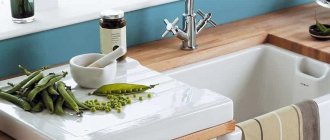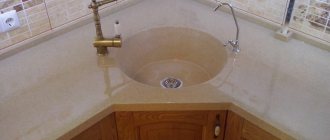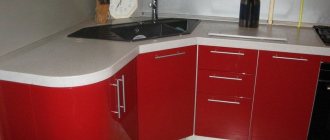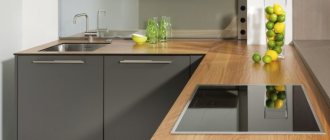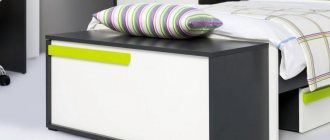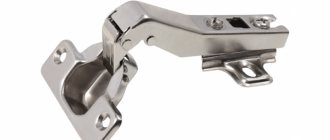Usually the choice has to be made from these two proposals, if you do not take into account natural stone. The latter is relatively rarely used for the production of utilitarian household items, since it is an expensive and rather fragile material.
Stainless steel is the most common option, but sinks made of artificial stone successfully compete with it. Products made from it are somewhat more expensive, but this is the case when the price is completely justified. They are almost eternal, and their excellent design makes the kitchen interior especially interesting, even elegant.
Stainless steel sinks: pros and cons
The advantages of steel sinks include their low cost and relative strength. They go well with metal faucets, although the latter are increasingly made from ceramics. In addition to the price, other positive properties can be noted:
- Resistance to aggressive household liquids, acids;
- Easy to clean - they do not absorb dirt and do not stain;
- They can withstand high temperatures (they are not afraid of a hot frying pan).
However, the quality greatly depends on the manufacturer, namely on the composition and thickness of the metal. If the sheet is thin (less than 0.8 mm), then it will sag under heavy dishes and dents will form on it. It is difficult to fix the mixer on such a panel. The stream of water that is turned on makes a fair amount of noise; over time, the shiny surface becomes dull, and it is impossible to return it to its original appearance. When choosing which sink is better, stainless steel or granite, you need to remember: steel products from well-known brands are very expensive.
- A square steel sink is a familiar attribute of the kitchen.
A significant drawback of stainless steel sinks is monotony. The only thing that changes is their shape: rectangular, round, square. There is no need to talk about the color palette and decorative possibilities here.
Review of materials and selection criteria
Stainless steel
An iron sink will fit perfectly into almost any interior.
The first thing you should pay attention to when choosing a sink is the material from which it is made. Its strength, reliability, durability and many other important characteristics will depend on this.
Today there are many models on the market made from a variety of materials, the most popular of which are:
Quartz sinks, steel and copper sinks, sinks made of marble, stainless steel, plastic, ceramics - this is an incomplete list of possible options.
Let us immediately note that the last two positions are in the least demand for quite objective reasons, since new materials confidently surpass them in characteristics. At the same time, the price of new materials, if higher, is quite justified; At the same time, it does not remove popular models from the sphere of financial capabilities of the general consumer.
Let's start the review with the most popular and affordable material for sinks today - stainless steel. This is an alloy of steel with an alloying metal - zinc or chromium. Today, for the production of kitchen sanitary ware, chromium martensitic steel grades AISI 304 and AISI 316L are used, which are completely safe and approved for use in the food industry.
There are two types of products - stamped and welded, the former are cheaper and worse in quality.
Stainless steel sinks look great in a wide variety of interior styles, from country to high-tech and postmodern.
In addition, they have a number of characteristic advantages:
The welded model has a deep bowl and thick walls.
Important! When choosing a stainless steel sink, it is best to purchase a model with a welded deep bowl and a wall thickness of at least 0.8 - 1 mm. It is also desirable to have a sound-absorbing pad.
Composite materials
Quartz sinks are also very popular.
The second place in popularity after stainless steel is occupied by composite materials, which are commonly called artificial stone. This material is somewhat more expensive than stainless steel, but has a number of significant advantages.
To make stone sinks, various mineral bases are used - quartz, marble or granite chips, etc. Next, the base is mixed with a polymer binder, most often acrylic resin, and formed by vibration casting into the desired product. High-quality models contain at least 80–94% mineral base.
Marble sink made of crumbs with polymer resin.
Sinks made of quartz agglomerate and marble chips have the following advantages:
Antique stone sinks are well suited for retro style interiors.
Important! When choosing a sink, beware of fakes and low-quality products with a low mineral content. Give preference to well-known brands and ask for certificates of conformity indicating the composition of the composite.
Ceramics
The photo shows a modern ceramic sink.
Ceramic products have long established themselves as the most hygienic and resistant to conditions of use as plumbing fixtures. Porcelain and sanitaryware are the undisputed leaders in terms of resistance to corrosion, external beauty and surface cleanliness.
However, in a kitchen sink, their use is complicated by their low impact strength and tendency to chip when heavy metal utensils fall, which, alas, is inevitable. Therefore, modern ceramic kitchen appliances have to be treated with special coatings, which, however, still do not provide a 100% guarantee of protection.
Ceramics look great in any room.
In this regard, the cost of really good ceramic models is quite high, and most often such products are classified as luxury plumbing fixtures. There are also difficulties with self-installation of devices due to their heavy weight and the risk of cracks and chips.
Ceramic bowls most often belong to the elite lines of sanitary ware.
Important! Porcelain stoneware products are often offered as ceramic sinks. It is a fairly high-quality material and surpasses ceramics in strength.
Artificial stone sinks, which are better?
To understand this, you need to imagine the technology of their manufacture. But first, let us note that artificial stone is a composite material, 80–90% consisting of sand and fragments of natural rocks. The binding mass is represented by acrylic resins with the addition of coloring pigments.
Manufacturing technology for “stone” sinks
The composite is obtained by mixing fine granite, quartz or marble sand with reagents that bind acrylic resins. The resulting mass is pressed and air bubbles are “squeezed” out of it. Different manufacturers add special components to it, trying to create a unique product.
For example, additives with silver ions give the material antibacterial properties, while hydrophobic impurities give it a “dirt-repellent” effect. Everyone has their own “know-how”, which is kept secret. There are two main technologies for the production of sinks.
- Cast products. The molten mass is poured into special molds, and they are coated with a special alloy - gelcoat, which forms a smooth, shiny surface. Such two-layer sinks are sometimes called “glued”, in contrast to a pure monolith. In the latter case, it has a homogeneous composition, and the surface is ground and polished.
- Bent forms. A “stone sheet” heated to a certain temperature is placed into the matrix, repeating its shape until a thin flat edge is created for connection with the surface of the cabinet.
2. Composite material with pink marble effect.
In terms of physical and mechanical parameters, products made by different methods differ little. To a large extent, the differences are due to the mineral composition of the filler and special additives. Therefore, the frequently asked question: which sink is better, granite or artificial stone, is not entirely correct. If granite chips are used in the mixture, then artificial granite is obtained, otherwise it will be “cast marble” or “quartz sink”.
3. If you order the sink and countertop from the same material, they will look like one whole, with virtually no visible seams.
Advantages of artificial stone products
Composite material based on natural stone chips has unique properties, and at the same time is significantly cheaper than natural analogues.
- Thanks to its dense texture, it is free of pores and cracks, absolutely hygienic, and does not absorb dirt and grease.
- The product can be given any design shape: oval, shell, or painted in an interesting shade.
- The durable surface holds polish for a long time, retains a beautiful appearance, and is easy to clean.
- Rare scratches can be sanded and polished, eliminating the damage without leaving a trace.
- Simple installation of the sink and adjustment to the countertop without gaps; no cracks form in them when drilling.
Which sink is better: marble, granite or quartz?
The answer is simple: all composites that imitate the listed natural rocks have good physical and mechanical properties and meet the requirements for household items. The choice is more a matter of taste and design. And yet, a sink made of marble or granite, which is better? What are the differences?
- Marble is a rock formed from limestone. It consists almost entirely of calcium, and a small admixture of iron (and other) oxides gives it a characteristic pink, creamy, greenish tint. Marble products are matte, with a warm surface, plastic. It absorbs dyes quite easily, so it is advisable to cover them with a protective layer.
- Granite is an igneous rock, much harder and more durable than marble. 55–65% of it is composed of quartz, the rest is feldspars and other minerals. This explains its “variegated” texture and variety of colors. It is more difficult to polish, the surface remains a little rough - it is perhaps most similar to “stone”.
- Quartz is a hard, brittle mineral that, when melted and fired, takes on a shiny, glassy appearance (the main component of glass). Polymer resins give the quartz sand-dominated material the necessary impact resistance.
The speckled pattern of granite is practical; stains and minor defects are not visible on it. Marble requires more careful handling and is more often used in classic-type interiors. Quartz sinks are not afraid of high temperatures, but not everyone likes their cold “glass” appearance.
5. The countertop and sink look like polished granite.
6. Stylish sink made of a composite with a predominance of quartz.
Features of marble and quartz
Cast marble and quartz agglomerate have an identical composition. Both types of artificial stone contain fractions of natural minerals, which are securely bonded with polyester resins. Sinks made from these materials:
Sinks and sinks made of artificial stone perfectly decorate the interior of the kitchen and bathroom, giving it prestige and respectability. The materials are perfectly combined with any coatings and plumbing equipment. Coloring pigments are added to the mass to give any shade. This makes it possible to choose the best option for a specific design.
The manufacturing technologies for sinks made of cast marble and quartz agglomerate are significantly different. Marble models are created using molds into which the prepared mass is poured. When it hardens, the product is removed and processed. Quartz sinks are made by processing a finished stone slab into the desired shape.
What to look for when choosing?
In an effort to overtake competitors, manufacturers are constantly improving the composition and design of their products. Therefore, when choosing a sink for the kitchen, you need to carefully read the instructions included with it. It is worth paying attention to the following characteristics.
- The content of mineral chips should not be lower than 80%. More resin will reduce heat resistance and strength.
- The composition of the stone filler - the more quartz, the better the abrasion resistance. But at the same time, fragility will also increase: granite sand is optimal in this regard.
- Temperature range - this indicator varies widely, from 200 to 500 degrees (in any case, you should not put pans in the sink directly from the stove).
- Antibacterial and dirt-repellent additives - they improve the quality of the material, facilitate maintenance and extend the service life of the product.
- There are sinks on sale without a cut-out hole for the faucet; this can be useful, since the wing can be turned in any direction.
The problem of which sink to choose, and which is better, artificial marble or granite, is solved depending on how actively it is used. The choice is also influenced by the style of interior design, and when it is installed: during a major renovation, or an old sink is being replaced without the intention of radically changing the furniture and appearance of the room. One thing is good: there are many offers, and you can find an option that suits the price and quality.
Kitchen plumbing fixtures are typically made from various types of metal alloys to ensure strength and durability.
A successful alternative to metal as a material for making sinks is a quartz composite containing a small amount of binding and coloring components.
Kitchen sinks made of quartz are not inferior to stainless steel containers, and surpass them in many consumer properties. The new material has found a large number of supporters, its position in ratings assessing the quality of plumbing fixtures for the kitchen is actively increasing.
Advantages of a quartz kitchen sink
The sink and the adjacent surface, made of quartz composite raw materials, appeared on the market relatively recently, but managed to impress users with a combination of the following positive qualities:
- appearance reminiscent of natural stone;
- ability to absorb the noise of falling water;
- absence of loud sounds when washing dishes (not like in stainless steel);
- smooth, uniform surface;
- resistance to detergents;
- environmental friendliness;
- durability;
- ease of care;
- possibility of repairs.
Which sink to choose: quartz agglomerate or cast marble
Relatively recently, stainless steel sinks were the absolute leader in the popularity ranking. Now these products have lost their leading positions, giving way to sinks made of artificial stone. These products are superior to their steel counterparts in terms of performance and aesthetics. There are several material options on the market. When purchasing a sink for a kitchen or bathroom, consumers most often choose between cast marble and quartz agglomerate. You don't have to limit yourself to models offered in retail stores. From ENOTSSTONE you can order an exclusive sink made of artificial stone according to your project.
How is quartz composite made?
Excellent consumer characteristics of quartz material for the manufacture of kitchen sinks, which has almost no disadvantages in its properties, are ensured by the implementation of the following technological stages of production:
- thorough mixing of the feedstock;
- homogeneous mass casting;
- molding products by pressing;
- hardening by thermal load;
- polishing surfaces.
The final stage is mandatory monitoring of quality indicators, preparation of a conclusion on the absence of disadvantages or defects in the product.
Some consumers do not see the difference between artificial quartz and artificial acrylic stone, believing that their composition is similar. In fact, the quartz composite used to make kitchen sinks contains a predominant portion of natural, non-porous silica. This is a huge advantage to the properties of the raw material. There is no natural component in acrylic stone, which is a big disadvantage.
What are the disadvantages
Do not place dishes in quartz sinks that have just been removed from the burner. Contact with hot material from a pot or pan may leave a mark on the surface of the sink. In this property, stainless steel outperforms composite.
The surface of many quartz kitchen sinks is coated with a special gelcoat-based compound. As a result, a decorative protective layer is formed on the product, which can be easily washed off from dirt with a soft sponge and ordinary detergents.
The sink cannot be cleaned with metal brushes or abrasive powders due to the high probability of damage to the surface. For some users, such restrictions are a significant disadvantage; they are used to scrubbing the sink with scourers made of metal threads.
Note! The advantage of quartz sinks is their high strength, however, if a large cast iron frying pan is dropped onto it from a height of half a meter, mechanical damage may occur.
For many buyers, the most important factor characterizing a product is price. For quartz sinks it is rather large, which is a disadvantage for a large number of potential owners, so they choose stainless steel.
The desire to buy is strengthened by the opportunity to use a beautiful, original sink. It will serve for many years without losing its attractiveness.
Installing a heavy sink requires the participation of several specialists. If the product has a non-standard shape or size, then diamond cutters will be needed for installation. The process may take several hours, but the result will be enjoyable every day.
Composite kitchen sinks are not without some disadvantages; they have both pros and cons, so manufacturers and experienced users warn about the specifics of their use.
What material to choose for washing?
Products made from cast marble look great in the interior and fit into classic and modern styles. You can make a model of any configuration by creating the desired mold for filling. The sinks have decent durability and are easy to clean from dirt.
However, this material has certain disadvantages. It is not resistant to high temperatures. Placing hot dishes in the sink may damage them. In order for a cast marble product to retain its original appearance, it must be polished periodically. Products containing abrasives should not be used for cleaning.
Quartz agglomerate does not have these disadvantages. This artificial stone maintains its integrity when in contact with hot objects. The sink can be cleaned with compounds containing abrasives. The product does not require polishing; it will fully retain its original characteristics for many years.
In our company you can order a kitchen and bathroom sink made of quartz agglomerate. We offer a wide range of materials from the world's leading brands in a large palette of shades.
Product range
Modern technology has been perfectly mastered by manufacturers; as a result, there are products of various colors and sizes on the plumbing market.
In small studio apartments, sinks with a shallow depth, up to 45 cm, look organic. They are often oval in shape and cut into the countertop of the work area.
In large kitchens, you can install a product with a wing to place clean dishes. Options for sink orientation may be different, because manufacturers prudently do not make a hole for the faucet.
Large kitchen spaces allow you to install quartz sinks with two containers, which is very convenient. In one container you can put large dishes before washing or vegetables that are prepared for processing.
A variety of color and texture solutions allows each buyer to purchase a sink taking into account the interior of the kitchen; sellers will be happy to help you choose a faucet so that the work area looks organic.
Modern housewives increasingly prefer to choose quartz sinks for the kitchen; metal options are losing their popularity. The artificial stone sink has a pleasant appearance, is easy to clean and pleasant to the touch. Also, during operation there is no unpleasant pressing noise or rumble.
The product has a high level of strength. Dye is used to give a special color. A quartz sink must be covered with gelcoat. This is a special material that performs a protective function. Thanks to this layer, the surface of the product becomes more resistant to mechanical stress, and the level of durability of the sink increases.
It is easy to use, the protective layer fills the pores in the stone, which makes the surface of the product smooth and pleasant to the touch. Due to its smoothness, the product is easy to wash, and the protective layer prevents plaque. A quartz sink with a gel coat is durable and retains its original characteristics for a long period of time.
Sink characteristics
When choosing a sink for your kitchen, you need to take into account all the pros and cons of the product.
This sink has a number of positive characteristics:
- Easy to care for;
- Resistance to mechanical damage and temperature changes, with the exception of products with a glossy surface, scratches may appear on it;
- Attractive appearance, suitable for any type of interior;
- The durability of the working surface thanks to the protective layer, the service life is at least ten years, with careful care of the product it increases several times;
- Safety, product manufacturing technology prevents the formation of harmful bacteria on the surface of the sink. Quartz kitchen sinks are made from natural material, so they do not emit harmful substances during operation;
- High level of strength;
- Easy to repair; if a scratch appears on the surface, it can be sanded using sandpaper. The chipped part of the product is glued with a special acrylic glue.
During operation, the housewives noted the following disadvantages:
- The surface cannot withstand too sharp temperature changes; you need to be careful with the sink. It is not advisable to place a saucepan or frying pan in it that has just been removed from the heat. This can damage the surface; as a rule, a mark remains that is not subsequently washed off;
- Too heavy objects can damage the integrity of the product; given the level of strength of the product, it can only be broken if you throw a cast-iron frying pan into it from a height or with great force. When choosing a sink, you need to pay attention to the quality of the product - this affects its strength;
- The appearance can be spoiled by the active use of abrasives and metal scrapers. A quartz sink does not require much effort to maintain during operation. There is no rust or unpleasant marks on the surface, so if you use the product correctly, you just need to wipe the surface of the product with a soft cloth;
- The main drawback is the price, but a sink of this type will please its owners for a long time without losing its appearance or performance characteristics. Therefore, it can be noted that the price of the product justifies itself.
